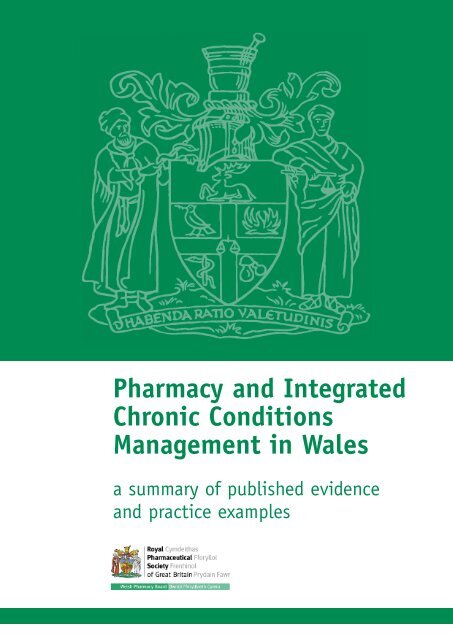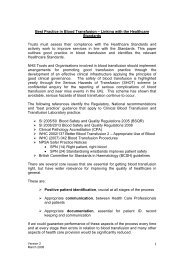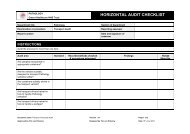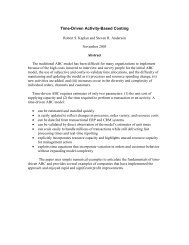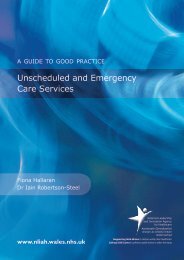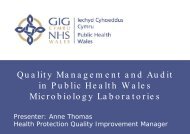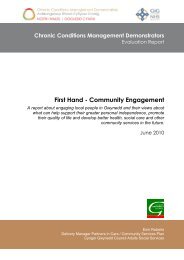Medicines Management - Pharmacy and ... - Health in Wales
Medicines Management - Pharmacy and ... - Health in Wales
Medicines Management - Pharmacy and ... - Health in Wales
You also want an ePaper? Increase the reach of your titles
YUMPU automatically turns print PDFs into web optimized ePapers that Google loves.
<strong>Pharmacy</strong> <strong>and</strong> Integrated<br />
Chronic Conditions<br />
<strong>Management</strong> <strong>in</strong> <strong>Wales</strong><br />
a summary of published evidence<br />
<strong>and</strong> practice examples
Acknowledgements<br />
This document has been produced by RPSGB <strong>and</strong> provides evidence † <strong>and</strong> practice examples of pharmacists role<br />
<strong>in</strong> support<strong>in</strong>g patients with chronic conditions.<br />
The practice examples <strong>and</strong> evidence to produce this document were collated by Professor Alison Blenk<strong>in</strong>sopp<br />
Professor of the Practice of <strong>Pharmacy</strong>, Department of <strong>Medic<strong>in</strong>es</strong> <strong>Management</strong>, Keele University, <strong>and</strong> Gianpiero<br />
Cel<strong>in</strong>o of Webstar <strong>Health</strong> on behalf of RPSGB.<br />
We would also wish to thank the many people who were <strong>in</strong>terviewed dur<strong>in</strong>g the production of this paper,<br />
<strong>and</strong>/or who provided <strong>in</strong>formation for the paper <strong>and</strong> the practice examples <strong>in</strong>cluded <strong>in</strong> the paper.<br />
† Literature searches for peer-reviewed studies covered the period up to autumn 2006<br />
©<br />
RBSGP 2008
Foreword<br />
In <strong>Wales</strong>, health <strong>and</strong> social care st<strong>and</strong>s at a critical po<strong>in</strong>t <strong>and</strong> fundamental<br />
changes are essential if we are to meet the challenges of modern day liv<strong>in</strong>g.<br />
Improv<strong>in</strong>g the way <strong>in</strong> which chronic conditions are managed is a vital step <strong>in</strong><br />
service re-design if the NHS <strong>and</strong> its partners are to meet the <strong>in</strong>creas<strong>in</strong>g<br />
dem<strong>and</strong>s placed on service providers.<br />
The launch of Designed to Improve <strong>Health</strong> <strong>and</strong> the<br />
<strong>Management</strong> of Chronic Conditions <strong>in</strong> <strong>Wales</strong> Service<br />
Improvement Plan 2007 – 2011 supports the<br />
translation of policy <strong>in</strong>to practice to ensure that<br />
the development of chronic conditions management<br />
services are an <strong>in</strong>tegral part of ma<strong>in</strong>stream<br />
service delivery.<br />
We recognise <strong>and</strong> value the important role that the<br />
pharmacy team will need to play <strong>in</strong> improv<strong>in</strong>g, for<br />
example, medic<strong>in</strong>es management, public health<br />
<strong>in</strong>formation <strong>and</strong> support, provid<strong>in</strong>g frontl<strong>in</strong>e support<br />
for self care <strong>and</strong> promot<strong>in</strong>g better prescrib<strong>in</strong>g.<br />
To help <strong>in</strong> this process this document draws<br />
together examples of <strong>in</strong>novative practice from<br />
across <strong>Wales</strong>. It demonstrates ways <strong>in</strong> which<br />
pharmacy practice is advanc<strong>in</strong>g to support the<br />
delivery of better <strong>and</strong> more susta<strong>in</strong>able services for<br />
people <strong>in</strong> <strong>Wales</strong> <strong>and</strong> provides an essential tool for<br />
ongo<strong>in</strong>g improvement.<br />
Ann Lloyd<br />
Head of Department for <strong>Health</strong> <strong>and</strong> Social Services<br />
Chief Executive NHS <strong>Wales</strong><br />
1
Contents<br />
Foreword 1<br />
Introduction 3<br />
Background 3<br />
<strong>Pharmacy</strong> <strong>in</strong> <strong>Wales</strong> 3<br />
National context 4<br />
Asthma <strong>and</strong> COPD 5<br />
Overview: 5<br />
Problem statement 5<br />
Policy context 5<br />
Summary of published evidence 6<br />
Practice examples 6<br />
Identify<strong>in</strong>g sub-optimal asthma control<br />
(Tier 2) - National 6<br />
Patient education <strong>in</strong> COPD <strong>and</strong> other chronic<br />
conditions (Tier 1/2/3) - Torfaen 6<br />
Coronary Heart Disease 7<br />
Overview: 7<br />
Problem statement 7<br />
Policy context 7<br />
Summary of published evidence 7<br />
Practice examples 8<br />
Pharmacist supplementary prescriber led cl<strong>in</strong>ic<br />
for patients with hypertension/ CVD (Tier 2/3)<br />
- Cardiff 8<br />
Prevention <strong>and</strong> management of coronary heart<br />
disease (Tier 1) - Pembrokeshire 8<br />
Multi-discipl<strong>in</strong>ary team support for patients<br />
with heart failure (Tier 3/4) - North East <strong>Wales</strong> 9<br />
Multi-discipl<strong>in</strong>ary GP based heart failure cl<strong>in</strong>ic<br />
(Tier 2/3) - Swansea 9<br />
Multi discipl<strong>in</strong>ary Heart Failure Service<br />
– (Tier 3) Greater Glasgow 9<br />
Community pharmacy based screen<strong>in</strong>g <strong>and</strong><br />
monitor<strong>in</strong>g of blood pressure (Tier 1/2/3)<br />
- National 9<br />
Diabetes 10<br />
Overview: 10<br />
Problem statement 10<br />
Policy context 10<br />
Summary of published evidence 11<br />
Practice examples 11<br />
Community pharmacist support for practice<br />
based cl<strong>in</strong>ics for diabetes (Tier 2) - Llanidloes 11<br />
Screen<strong>in</strong>g for diabetes (Tier 1/2) – National 11<br />
Integrated diabetes service (Tier 2) – Hill<strong>in</strong>gdon11<br />
Arthritis <strong>and</strong> Chronic Musculoskeletal<br />
Conditions 12<br />
Overview: 12<br />
Problem statement 12<br />
Policy context 12<br />
Summary of published evidence 12<br />
Practice examples 13<br />
Pharmacist led cl<strong>in</strong>ic for patients with<br />
rheumatoid arthritis (Tier 2/3) – Cardiff 13<br />
Tackl<strong>in</strong>g chronic pa<strong>in</strong> (Tier 2/3/4) – Fife 13<br />
Epilepsy 14<br />
Overview: 14<br />
Problem statement 14<br />
Policy context 14<br />
Published evidence 14<br />
Practice examples 14<br />
Epilepsy medic<strong>in</strong>es reviews <strong>in</strong> primary care<br />
(Tier 1/2/3/4) – South Huddersfield 14<br />
Scottish Pharmaceutical Care Model Schemes<br />
(PCMS) 14<br />
Multiple chronic conditions 15<br />
Overview: 15<br />
Practice examples 15<br />
Medication review <strong>in</strong> the Elderly Care Assessment<br />
Service (ECAS) (Tier 3/4) – Cardiff 15<br />
Home support <strong>in</strong> medic<strong>in</strong>e tak<strong>in</strong>g for vulnerable<br />
patients (CARMAS) (Tier 3/4) – Cardiff 16<br />
Community pharmacists work<strong>in</strong>g with community<br />
matrons to support case management<br />
(Tier 3/4) – Swansea 16<br />
Torfaen Medication Adm<strong>in</strong>istration Scheme 17<br />
Medication review <strong>in</strong> general practices (Tier 2)<br />
– Conway 17<br />
Medication review (Tier 3/4) - Caerphilly 17<br />
Jo<strong>in</strong>t work<strong>in</strong>g by community pharmacists<br />
<strong>and</strong> LHB pharmacists <strong>in</strong> CCM (Tier 2/3)<br />
– North West <strong>Wales</strong> 17<br />
Community pharmacist support for patients<br />
<strong>in</strong> care homes - Newport 18<br />
Medication Usage Review <strong>in</strong> Care Homes<br />
(MURCH) Study 18<br />
<strong>Medic<strong>in</strong>es</strong> support service <strong>in</strong> people’s homes<br />
(Tier 3/4) – Derbyshire 18<br />
Warfar<strong>in</strong> Cl<strong>in</strong>ic – Neath Port Talbot General<br />
Hospital 18<br />
References 19<br />
Notes 20<br />
2
<strong>Pharmacy</strong> <strong>and</strong> Integrated Chronic Conditions<br />
<strong>Management</strong> <strong>in</strong> <strong>Wales</strong><br />
Introduction<br />
Designed to Improve <strong>Health</strong> <strong>and</strong> the<br />
<strong>Management</strong> of Chronic Conditions <strong>in</strong> <strong>Wales</strong><br />
- an <strong>in</strong>tegrated model <strong>and</strong> framework 1<br />
acknowledges that pharmacy development is<br />
one of its eight ‘Foundations for Change’<br />
stat<strong>in</strong>g that:<br />
“The correct adm<strong>in</strong>istration <strong>and</strong> use of medic<strong>in</strong>es<br />
is <strong>in</strong>tegral to good chronic conditions<br />
management <strong>and</strong> community pharmacists play an<br />
important role <strong>in</strong> support<strong>in</strong>g this. This <strong>in</strong>cludes<br />
improv<strong>in</strong>g medic<strong>in</strong>es management, provid<strong>in</strong>g front<br />
l<strong>in</strong>e <strong>in</strong>formation <strong>and</strong> support for better prescrib<strong>in</strong>g<br />
<strong>in</strong> a community <strong>and</strong> acute sett<strong>in</strong>g <strong>and</strong> support<strong>in</strong>g<br />
hospital discharge. Identify<strong>in</strong>g how the pharmacy<br />
contract <strong>and</strong> other developments such as<br />
enhanced services could support better patient<br />
care will need to be exam<strong>in</strong>ed.”<br />
This resource document provides the evidence base<br />
to support service development <strong>and</strong> <strong>in</strong>tegrate<br />
pharmacy <strong>in</strong>to care pathways for the management of<br />
people with chronic conditions. It highlights<br />
examples of <strong>in</strong>novative practice currently happen<strong>in</strong>g<br />
<strong>in</strong> <strong>Wales</strong> <strong>and</strong> across the UK <strong>and</strong> should be used as a<br />
resource to help facilitate the development of<br />
pharmacy based services that can achieve the<br />
<strong>in</strong>tegrated model <strong>and</strong> framework.<br />
Background<br />
Chronic conditions are those which <strong>in</strong> most<br />
cases cannot be cured, only controlled <strong>and</strong><br />
are often life-long <strong>and</strong> limit<strong>in</strong>g <strong>in</strong> terms of<br />
quality of life.<br />
<strong>Health</strong>care services <strong>in</strong> <strong>Wales</strong> are currently reactive<br />
rather than preventive. It has been found that<br />
<strong>in</strong>tensive users of <strong>in</strong>patient secondary care services<br />
have on average three chronic conditions <strong>and</strong> about<br />
six per cent of adults report hav<strong>in</strong>g three or more<br />
chronic conditions 2 suggest<strong>in</strong>g that it is just a small<br />
percentage of the population that are <strong>in</strong>tensive users<br />
of secondary care services. There is a need for better<br />
management of people with chronic conditions <strong>in</strong> the<br />
community keep<strong>in</strong>g people <strong>in</strong> best health for as long<br />
as possible thus reduc<strong>in</strong>g the need for admissions<br />
<strong>in</strong>to hospital.<br />
Almost all people with chronic conditions are<br />
rout<strong>in</strong>ely managed with prescribed medic<strong>in</strong>es. The<br />
likelihood is that both community pharmacy <strong>and</strong><br />
hospital pharmacy is a regular port of call for this<br />
group of people. This ongo<strong>in</strong>g relationship provides<br />
an ideal opportunity for pharmacy to address the<br />
need for support<strong>in</strong>g people with chronic conditions<br />
at all levels of the <strong>Wales</strong> Chronic Condition Model<br />
(fig 1 overleaf).<br />
<strong>Pharmacy</strong> <strong>in</strong> <strong>Wales</strong><br />
<strong>Pharmacy</strong> <strong>in</strong> <strong>Wales</strong> is a diverse <strong>and</strong> dynamic<br />
profession work<strong>in</strong>g at all levels with<strong>in</strong> the NHS to<br />
ensure that patients get the best from their<br />
medic<strong>in</strong>es <strong>and</strong> that healthcare professionals have<br />
access to advice <strong>and</strong> support.<br />
The pharmacy network is varied <strong>and</strong> far reach<strong>in</strong>g<br />
compris<strong>in</strong>g of over 700 community pharmacies 3<br />
provid<strong>in</strong>g patients with dispens<strong>in</strong>g services, support<br />
<strong>in</strong> self-care <strong>and</strong> services under the community<br />
pharmacy contract. Pharmacists work<strong>in</strong>g with<strong>in</strong> each<br />
of the Local <strong>Health</strong> Boards (LHBs) provid<strong>in</strong>g<br />
prescrib<strong>in</strong>g advice to GP’s, develop<strong>in</strong>g pharmacy<br />
based services, undertak<strong>in</strong>g chronic condition<br />
management, prison pharmacists <strong>and</strong> pharmacists<br />
work<strong>in</strong>g with<strong>in</strong> Secondary Care provid<strong>in</strong>g medic<strong>in</strong>es<br />
management services, therapeutic drug monitor<strong>in</strong>g<br />
<strong>and</strong> <strong>in</strong> some cases runn<strong>in</strong>g specialist cl<strong>in</strong>ics. This<br />
network of professionals <strong>and</strong> developments <strong>in</strong> the<br />
pharmacy profession provide an opportunity for<br />
<strong>in</strong>novation <strong>in</strong> the care of people with chronic<br />
conditions.<br />
3
National Context<br />
Tackl<strong>in</strong>g the challenge of chronic conditions <strong>in</strong> <strong>Wales</strong> is a critical step <strong>in</strong> achiev<strong>in</strong>g the aspirations set out <strong>in</strong><br />
Designed for Life: Creat<strong>in</strong>g World Class <strong>Health</strong> <strong>and</strong> Social Care for <strong>Wales</strong> <strong>in</strong> the 21st Century 4 .<br />
The need for greater <strong>and</strong> more effective <strong>in</strong>tegration <strong>in</strong> the management of chronic conditions across all health<br />
<strong>and</strong> social care discipl<strong>in</strong>es has been identified by the Welsh Assembly’s designed to improve <strong>Health</strong> <strong>and</strong> the<br />
management of Chronic Conditions <strong>in</strong> <strong>Wales</strong>.<br />
Figure 1 The Welsh Chronic Conditions <strong>Management</strong> Model<br />
The Welsh Chronic Conditions <strong>Management</strong> Model<br />
highlighted <strong>in</strong> figure 1 builds on other similar models<br />
of care, but also recognises the important<br />
contribution of prevention <strong>and</strong> the need for an<br />
<strong>in</strong>tegrated, multidiscipl<strong>in</strong>ary approach across all tiers.<br />
This model stratifies the whole population accord<strong>in</strong>g<br />
to <strong>in</strong>creas<strong>in</strong>g risk from chronic conditions <strong>and</strong><br />
therefore allows a clearer basis to coord<strong>in</strong>ate<br />
plann<strong>in</strong>g, service delivery, care <strong>and</strong> support.<br />
In consider<strong>in</strong>g the potential contribution of<br />
pharmacy it is important to attempt to quantify <strong>and</strong><br />
reflect on the patient profile for the most common<br />
chronic conditions. Data from the National Public<br />
<strong>Health</strong> Service for <strong>Wales</strong> (NPHS) 5 has enabled a<br />
calculation of national prevalence for a range<br />
of conditions.<br />
Furthermore analysis of data from the Welsh <strong>Health</strong><br />
Survey 2004 6 shows that around one third of people<br />
over sixty five years old report hav<strong>in</strong>g more than one<br />
chronic condition <strong>and</strong> that eighty percent of adults<br />
reported us<strong>in</strong>g a community pharmacist <strong>in</strong> the last<br />
twelve months. Therefore the likelihood is that<br />
community pharmacists are already see<strong>in</strong>g many<br />
patients with chronic diseases, many of whom will<br />
have multiple morbidities. It is also important to<br />
bear <strong>in</strong> m<strong>in</strong>d the relationship between lifestyle <strong>and</strong><br />
chronic conditions. Community pharmacies can be of<br />
particular value <strong>in</strong> prevention because they see<br />
healthy people as well as those who are ill.<br />
4
Asthma <strong>and</strong> COPD<br />
Overview<br />
There are some 230,000 people <strong>in</strong> <strong>Wales</strong> with asthma <strong>and</strong> 31,000 with chronic obstructive pulmonary<br />
disease (COPD)<br />
The average community pharmacy <strong>in</strong> <strong>Wales</strong> serves around 327 people with asthma <strong>and</strong> 44 people<br />
with COPD<br />
Eleven <strong>in</strong>tervention trials were reviewed of community pharmacy-based asthma services. Most of<br />
these showed positive effects<br />
The most effective use of community pharmacy resources will be to focus on those whose asthma is<br />
less well controlled<br />
Several models of community pharmacy based asthma care are offered <strong>in</strong> the UK, usually on a pilot<br />
basis<br />
A national medic<strong>in</strong>es use review (MUR) service for people with asthma provided by Lloyds <strong>Pharmacy</strong><br />
has demonstrated positive outcomes <strong>and</strong> is a model for the future<br />
Only one published trial was found of pharmacist <strong>in</strong>terventions <strong>in</strong> COPD, <strong>in</strong> community pharmacy.<br />
Patients reported improvements <strong>in</strong> symptoms but there was no change <strong>in</strong> objective cl<strong>in</strong>ical measures.<br />
Problem statement<br />
Around 230,000 people <strong>in</strong> <strong>Wales</strong> suffer from Asthma.<br />
Asthma is the only chronic disease where those most<br />
affected is the young. A recent review of asthma <strong>in</strong><br />
the UK by Asthma UK reveals that the number of<br />
people with asthma has grown by 400,000 s<strong>in</strong>ce<br />
2001. Diagnosis of asthma is grow<strong>in</strong>g fastest among<br />
adults with growth <strong>in</strong> children slow<strong>in</strong>g when<br />
compared to historical trends. We do not know why<br />
this is happen<strong>in</strong>g. Nevertheless one <strong>in</strong> ten children<br />
<strong>and</strong> 590,000 teenagers have a diagnosis of asthma,<br />
6% of sufferers reported hav<strong>in</strong>g emergency treatment<br />
<strong>in</strong> last month with 4,036 hospital admissions due to<br />
asthma <strong>in</strong> <strong>Wales</strong>. Each year there are 77 deaths from<br />
asthma <strong>in</strong> <strong>Wales</strong>.<br />
Summary of published evidence<br />
Work recently undertaken on behalf of the Royal<br />
Pharmaceutical Society of Great Brita<strong>in</strong> (RPSGB)<br />
identified <strong>and</strong> reviewed ten studies, most of which<br />
were conducted <strong>in</strong> Europe, Canada <strong>and</strong> the USA 7<br />
together with a 2003 review article which conducted<br />
a detailed analysis of four studies 8 . The Asheville<br />
asthma study has also been reviewed 9 .<br />
Almost all of the studies showed positive effects on<br />
patients’ self-reported symptoms <strong>and</strong> some showed<br />
improvements <strong>in</strong> asthma-related quality of life. Fewer<br />
studies demonstrated significant improvements <strong>in</strong><br />
Peak Expiratory Flow Rates.<br />
Policy context<br />
There is no National Service Framework for asthma,<br />
although the pr<strong>in</strong>ciples of the Long Term Conditions<br />
strategy apply.<br />
5
Practice examples<br />
Identify<strong>in</strong>g sub-optimal asthma control (Tier 2)<br />
– National<br />
Lloyd’s pharmacy, <strong>in</strong> partnership with Asthma UK,<br />
co-ord<strong>in</strong>ated a targeted approach <strong>in</strong> which their<br />
pharmacists identified people whose asthma was less<br />
well controlled <strong>and</strong> offered them a <strong>Medic<strong>in</strong>es</strong> Use<br />
Review. The results from 200 pharmacies<br />
demonstrated that:<br />
◗ Over half were us<strong>in</strong>g their reliever <strong>in</strong>haler too<br />
frequently.<br />
◗ Just over two thirds of the patients whose asthma<br />
was sub-optimally controlled were referred to their<br />
GP where changes to prescribed treatment were<br />
made <strong>in</strong> almost two thirds of these cases.<br />
Contact: Clare Kerr<br />
Clare.Kerr@lloydspharmacy.co.uk<br />
Patient education <strong>in</strong> COPD <strong>and</strong> other chronic<br />
conditions (Tier 1/2/3) – Torfaen<br />
Pharmacists work<strong>in</strong>g <strong>in</strong> Torfaen LHB have delivered<br />
educational sessions on medication at Structured<br />
Education Course Groups facilitated by the Long<br />
Term Conditions Specialist Nurses. These sessions<br />
have <strong>in</strong>cluded COPD, diabetes, the cardiac exercise<br />
group <strong>and</strong> the stroke rehabilitation group. The<br />
sessions were well received by patients as they<br />
allowed for two way discussions about their disease<br />
management, <strong>and</strong> provided a opportunity for broader<br />
discussion about the pharmacy contract, the costs of<br />
medic<strong>in</strong>es, br<strong>and</strong>ed <strong>and</strong> generic medic<strong>in</strong>es.<br />
Contact:<br />
Wendy Tyler-Batt, Torfaen LHB<br />
Wendy.TylerBatt@torfaenlhb.wales.nhs.uk<br />
6
Coronary Heart Disease<br />
Overview:<br />
<strong>Wales</strong> has 233,000 people with a diagnosis of a heart condition<br />
The average community pharmacy <strong>in</strong> <strong>Wales</strong> serves 185 people with ang<strong>in</strong>a, has 161 people who have<br />
had a heart attack <strong>and</strong> who will be tak<strong>in</strong>g prescribed treatment <strong>and</strong> 57 people with heart failure<br />
The published literature <strong>in</strong>cludes several trials of community pharmacy-based services which aim to<br />
reduce risk factors for CHD<br />
There is good evidence that community pharmacy based services result <strong>in</strong> improved lipid levels <strong>and</strong><br />
more patients reach<strong>in</strong>g lipid targets<br />
There is some evidence that community pharmacy services can improve blood pressure control<br />
There is good published evidence that hospital pharmacist <strong>in</strong>volvement <strong>in</strong> the heart failure team<br />
leads to improved outcomes <strong>in</strong> terms of reduced hospital admissions <strong>and</strong> reduced bed days as well as<br />
improved implementation of evidence based therapy<br />
Po<strong>in</strong>t of care test<strong>in</strong>g for blood pressure <strong>and</strong> lipids is <strong>in</strong>creas<strong>in</strong>gly offered <strong>in</strong> community pharmacies<br />
but <strong>in</strong>tegration <strong>and</strong> use of this data with<strong>in</strong> the wider NHS is unclear<br />
The Welsh visit to Kaiser Permanente found that pharmacist were provid<strong>in</strong>g several services <strong>in</strong> CHD<br />
management <strong>in</strong>clud<strong>in</strong>g lead<strong>in</strong>g cl<strong>in</strong>ics to follow the progress of patients with hypertension,<br />
<strong>in</strong>itiat<strong>in</strong>g cholesterol-lower<strong>in</strong>g medication, adjust<strong>in</strong>g medication doses <strong>and</strong> order<strong>in</strong>g laboratory tests,<br />
<strong>and</strong> approv<strong>in</strong>g patients repeat medication<br />
Problem statement<br />
Coronary heart disease (CHD) kills more than 8,600<br />
people <strong>in</strong> <strong>Wales</strong> every year. More than 1.4 million<br />
people suffer from ang<strong>in</strong>a <strong>and</strong> 22,000 people <strong>in</strong><br />
<strong>Wales</strong> have a heart attack annually. Around 2,300 of<br />
these deaths are premature, occurr<strong>in</strong>g <strong>in</strong> people<br />
under 75. An estimated 32,000 cases of heart failure<br />
are diagnosed <strong>in</strong> <strong>Wales</strong> each year <strong>and</strong> 96,000<br />
patients need<strong>in</strong>g ongo<strong>in</strong>g care 10 . 10,400 people each<br />
year die from heart failure <strong>in</strong> Engl<strong>and</strong> <strong>and</strong> <strong>Wales</strong>.<br />
Policy context<br />
The NHS <strong>in</strong> <strong>Wales</strong> has a National Service Framework,<br />
‘Tackl<strong>in</strong>g CHD <strong>in</strong> <strong>Wales</strong>’ 11 . The key targets for <strong>Wales</strong> <strong>in</strong><br />
relation to CHD are:<br />
◗ To reduce CHD mortality <strong>in</strong> 65-74 year olds from<br />
600 per 100,000 <strong>in</strong> 2002 to 400 per 100,000 <strong>in</strong><br />
2012.<br />
◗ To improve CHD mortality <strong>in</strong> all groups <strong>and</strong> at the<br />
same time aim for a more rapid improvement <strong>in</strong><br />
the most deprived groups.<br />
◗ To reduce stroke mortality <strong>in</strong> 65-74 year olds by<br />
20 per cent by 2012.<br />
These figures suggest that there is scope for<br />
pharmacists to contribute to CHD management.<br />
Summary of published evidence<br />
An earlier review of studies published between 1990<br />
<strong>and</strong> 2001 <strong>in</strong>cluded four studies of community<br />
pharmacy based hyperlipidaemia management (two<br />
R<strong>and</strong>om Controlled Trials (RCTs) <strong>and</strong> two<br />
observational studies) 12 that review concluded that<br />
“The RCTs provide conv<strong>in</strong>c<strong>in</strong>g evidence, supported by<br />
the other studies, that community pharmacists have<br />
an important role to play <strong>in</strong> manag<strong>in</strong>g lipid levels.<br />
Community pharmacists offer the potential to improve<br />
the use of the resources <strong>in</strong>vested <strong>in</strong> <strong>and</strong> the outcomes<br />
of lipid management”. We identified four addtional<br />
more recent studies, one of which was the f<strong>in</strong>al<br />
publication of an RCT <strong>in</strong>cluded <strong>in</strong> the orig<strong>in</strong>al<br />
review 13 . There is good evidence from <strong>in</strong>tervention<br />
studies <strong>in</strong> hyperlipidaemia that community pharmacy<br />
based services result <strong>in</strong> more patients reach<strong>in</strong>g their<br />
target lipid levels.<br />
A recent Scottish study of people with heart failure<br />
<strong>and</strong> their carers found that treatment regimens were<br />
reported to be difficult to comply with. Patients<br />
thought health professionals provided little support<br />
for medication management. Pharmacists were<br />
viewed as be<strong>in</strong>g a good <strong>and</strong> accessible source of<br />
practical support <strong>and</strong> were also viewed as<br />
knowledgeable about the <strong>in</strong>dividual's heart health<br />
history. The authors concluded that an “extended role<br />
for pharmacists <strong>in</strong> support<strong>in</strong>g patients with heart<br />
failure should be encouraged”. 14<br />
7
Five r<strong>and</strong>omised controlled trials were identified <strong>and</strong> reviewed for pharmacist <strong>in</strong>put to the management<br />
of heart failure. Three of the trials were hospital based <strong>and</strong> two were community pharmacy based. All had<br />
positive f<strong>in</strong>d<strong>in</strong>gs. Both hospital <strong>and</strong> community pharmacist <strong>in</strong>terventions significantly improved compliance<br />
with treatment. 15,16<br />
Hospital based pharmacist <strong>in</strong>terventions reduced re-admissions <strong>and</strong> the number of patient bed days 17,18 <strong>and</strong> all<br />
cause mortality 19 . A recent systematic review of evidence on the contribution of different health professionals<br />
<strong>in</strong> heart failure teams concluded that “depend<strong>in</strong>g on the local health care system, a pharmacist can play a role<br />
<strong>in</strong> judg<strong>in</strong>g <strong>and</strong> evaluat<strong>in</strong>g treatment guidel<strong>in</strong>es <strong>and</strong> <strong>in</strong>itiat<strong>in</strong>g appropriate evidence based therapy. In addition<br />
pharmacists can check on possible drug <strong>in</strong>teractions, treat adverse events <strong>and</strong> have a possible role <strong>in</strong> the<br />
education of patients <strong>and</strong> of physicians” 20 . The Welsh CHD policy document ‘Tackl<strong>in</strong>g CHD <strong>in</strong> <strong>Wales</strong>’ 21 also noted<br />
“It has been shown that patients with heart failure benefit from the care of cl<strong>in</strong>ical pharmacists. Their <strong>in</strong>clusion<br />
<strong>in</strong> the heart failure team is essential”.<br />
Practice examples<br />
Pharmacist supplementary prescriber led cl<strong>in</strong>ic<br />
for patients with hypertension/ CVD (Tier 2/3)<br />
– Cardiff<br />
A Cardiff community pharmacist supplementary<br />
prescriber based <strong>in</strong> a GP practice runs a<br />
Hypertension/CVD risk management cl<strong>in</strong>ic. Patients<br />
are identified from the practice’s hypertension <strong>and</strong><br />
CHD registers <strong>and</strong> given an appo<strong>in</strong>tment with the<br />
pharmacist. The pharmacists operates with<strong>in</strong> a pre<br />
agreed generic cl<strong>in</strong>ical management plan cover<strong>in</strong>g<br />
the prescrib<strong>in</strong>g of anti-hypertensives, Stat<strong>in</strong>s, Aspir<strong>in</strong><br />
<strong>and</strong> Orlistat. Patients have all the appropriate blood<br />
tests carried out prior to their appo<strong>in</strong>tment <strong>and</strong> the<br />
pharmacist is responsible for manag<strong>in</strong>g their BP <strong>and</strong><br />
CVD risk to the best possible outcome. The<br />
pharmacist will order any follow up tests required<br />
<strong>and</strong> refer to GP’s when appropriate, the cl<strong>in</strong>ic also<br />
<strong>in</strong>corporates elements of medication review.<br />
Contact: Mike Wall<strong>in</strong>gton<br />
Mikewall<strong>in</strong>gton@aol.com<br />
Prevention <strong>and</strong> management of coronary heart<br />
disease (Tier 1) – Pembrokeshire<br />
The Pembrokeshire Coronary Heart <strong>Health</strong> Project<br />
<strong>in</strong>cludes four community pharmacies which offer<br />
opportunistic lifestyle based risk assessment for<br />
patients identified as likely to have significant risk<br />
factors for the development of CHD <strong>in</strong> the near<br />
future. The pharmacies concentrate on identify<strong>in</strong>g<br />
those people who do not access their GP, thus<br />
<strong>in</strong>creas<strong>in</strong>g coverage of the population. Referrals to<br />
healthy eat<strong>in</strong>g advisors can also be made from the<br />
pharmacies. Audit of the first 40 people to<br />
participate <strong>in</strong> the scheme showed that<br />
◗ Half had a CHD risk over 15%.<br />
◗ With one <strong>in</strong> ten of these hav<strong>in</strong>g a CHD risk<br />
over 30%.<br />
◗ One <strong>in</strong> four had already been diagnosed with a<br />
heart condition.<br />
◗ Half had a family history of heart disease.<br />
This early data <strong>in</strong>dicates that the scheme is<br />
achiev<strong>in</strong>g its objectives.<br />
In another component of the project eight GP<br />
practices provide primary prevention screen<strong>in</strong>g for<br />
CHD. One practice employs a LHB pharmacist to<br />
manage identified areas of risk <strong>in</strong>clud<strong>in</strong>g<br />
hypertension, hypercholesterolemia <strong>and</strong> smok<strong>in</strong>g<br />
cessation. The pharmacist is qualified as a<br />
supplementary prescriber <strong>and</strong> can adjust treatment<br />
accord<strong>in</strong>g to an agreed cl<strong>in</strong>ical management plan.<br />
Treatment is based on CV risk with a 10 year risk of<br />
> 20% be<strong>in</strong>g the trigger for <strong>in</strong>tensive management.<br />
Patients with less than this risk are offered advice<br />
on diet, exercise, <strong>and</strong> smok<strong>in</strong>g cessation. Those<br />
patients at > 20% risk are offered similar lifestyle<br />
<strong>in</strong>terventions for at least 3 months <strong>and</strong> then if<br />
appropriate medication is prescribed accord<strong>in</strong>g to an<br />
agreed cl<strong>in</strong>ical management plan. The pharmacist is<br />
employed by the practice for one session per week<br />
dur<strong>in</strong>g which he sees patients <strong>and</strong> reviews results<br />
<strong>and</strong> other <strong>in</strong>formation to identify patients for<br />
future cl<strong>in</strong>ics.<br />
Contact: Rebecca Evans<br />
<strong>Health</strong> Inequalities Programme Manager<br />
Rebecca.Evans@pembrokeshirelhb.wales.nhs.uk<br />
8
Multi-discipl<strong>in</strong>ary team support for patients with<br />
heart failure (Tier 3/4) – North East <strong>Wales</strong><br />
A hospital-based multi-discipl<strong>in</strong>ary team compris<strong>in</strong>g<br />
a pharmacist <strong>and</strong> three specialist nurses provide<br />
support for patients with heart failure <strong>in</strong> North East<br />
<strong>Wales</strong>. In addition to see<strong>in</strong>g patients who have been<br />
admitted to hospital, patients with<br />
echocardiographically confirmed heart failure are<br />
referred <strong>in</strong>to the service by consultants, GPs <strong>and</strong><br />
through the Diagnostic Heart Failure Cl<strong>in</strong>ic. Patients<br />
are categorised <strong>in</strong>to two groups accord<strong>in</strong>g to severity<br />
of their condition <strong>and</strong> are then offered care packages<br />
accord<strong>in</strong>gly. All patients are seen <strong>in</strong>itially by both a<br />
nurse <strong>and</strong> pharmacist. The pharmacist <strong>and</strong> nurses are<br />
qualified supplementary prescribers <strong>and</strong> can adjust<br />
the patient’s treatment <strong>in</strong> l<strong>in</strong>e with an agreed<br />
cl<strong>in</strong>ical management plan based on relevant national<br />
guidel<strong>in</strong>es for heart failure.<br />
An audit of outcomes was undertaken <strong>in</strong> 2004, two<br />
years after the service began. The data showed<br />
substantial reductions <strong>in</strong> hospital admissions (both<br />
heart failure <strong>and</strong> all cause admissions) <strong>and</strong> hospital<br />
bed days <strong>and</strong> the local health commissioners made it<br />
a substantive service from that time.<br />
Contact: Jenny Welst<strong>and</strong><br />
jennywelst<strong>and</strong>@new-tr.wales.nhs.uk<br />
Multi discipl<strong>in</strong>ary Heart Failure Service<br />
(Tier 3) – Greater Glasgow<br />
Community <strong>and</strong> hospital pharmacists <strong>in</strong> Glasgow<br />
work together with specialist heart failure nurses to<br />
support <strong>and</strong> monitor patients <strong>in</strong> primary care.<br />
Pilot work had identified that 38 of every 1000<br />
people aged over 65 years <strong>in</strong> Glasgow have heart<br />
failure. Of these, two-thirds were tak<strong>in</strong>g ACE<strong>in</strong>hibitors<br />
but only one-third were on the correct<br />
dose. The situation was worse for beta-blockers: one<br />
third of patients were tak<strong>in</strong>g beta-blockers but only<br />
a third was prescribed a dose that is known to work.<br />
Before the patient leaves hospital they have a<br />
medication review with the hospital pharmacist who<br />
ensures they are discharged on appropriate<br />
treatment. The patient’s local community pharmacist<br />
is contacted by the hospital <strong>and</strong> carries out a<br />
medic<strong>in</strong>es review with the patient once they are out<br />
of hospital. Education <strong>and</strong> advice are provided for<br />
the patient <strong>and</strong> the pharmacist uses the local<br />
formulary as the basis to suggest necessary<br />
adjustments <strong>in</strong> medic<strong>in</strong>es <strong>and</strong> doses to the GP if this<br />
is needed. Almost all GP practices <strong>and</strong> the majority<br />
of community pharmacists participate <strong>in</strong> the scheme.<br />
Contact: Ricky Lowrie<br />
richard.lowrie@gartnavel.glacomen.scot.nhs.uk<br />
Multi-discipl<strong>in</strong>ary GP based heart failure cl<strong>in</strong>ic<br />
(Tier 2/3) – Swansea<br />
A general practice based multi-discipl<strong>in</strong>ary heart<br />
failure cl<strong>in</strong>ic <strong>in</strong> Swansea <strong>and</strong> <strong>in</strong> Pembrokeshire. The<br />
pharmacist searches the practice computer system to<br />
identify patients to <strong>in</strong>vite to the cl<strong>in</strong>ic. Dur<strong>in</strong>g a<br />
consultation the patient’s has a medication review<br />
focus<strong>in</strong>g on the effective use of ACE <strong>in</strong>hibitors <strong>and</strong><br />
beta blockers, supported by lifestyle advice. The<br />
pharmacists are supplementary prescribers work<strong>in</strong>g<br />
with<strong>in</strong> a cl<strong>in</strong>ical management plan to adjust<br />
patients’ treatment, <strong>and</strong> <strong>in</strong>itiate treatment where<br />
neccessary.<br />
Contact: Sue Collis<br />
sue.collis@swansealhb.wales.nhs.uk<br />
Don Wilkes<br />
don.wilkes@pembrokeshirelhb.wales.nhs.uk<br />
Community pharmacy based screen<strong>in</strong>g <strong>and</strong><br />
monitor<strong>in</strong>g of blood pressure (Tier 1/2/3)<br />
– National<br />
Lloyds <strong>Pharmacy</strong> provides a blood pressure measur<strong>in</strong>g<br />
service where by people may have their blood<br />
pressure monitored; the service is for known<br />
hypertensive patients <strong>and</strong> ad hoc <strong>in</strong>terventions. The<br />
blood pressure is measured under a St<strong>and</strong>ard<br />
Operat<strong>in</strong>g Procedure under which appropriate people<br />
are given lifestyle advice or told to return for further<br />
measurement. In <strong>Wales</strong> to date over 16,000 blood<br />
pressure read<strong>in</strong>gs have been taken with just under<br />
2,000 people be<strong>in</strong>g referred to their GP’s surgery.<br />
Contact:<br />
Ian Morgan<br />
ian.morgan@lloydspharmacy.co.uk<br />
9
Diabetes<br />
Overview:<br />
Diabetes UK estimates that there are 92,000 people with diabetes <strong>in</strong> <strong>Wales</strong><br />
The average community pharmacy <strong>in</strong> <strong>Wales</strong> serves 173 people with diabetes, 154 of whom will have<br />
Type-2 diabetes<br />
The published literature <strong>in</strong>cludes several trials of community pharmacy-based diabetes services<br />
Most of the trials which measured diabetes control showed positive effects<br />
One pharmacy based diabetes care service <strong>in</strong> the UK (the Hill<strong>in</strong>gdon service) had a robust<br />
evaluation. With both the trial results <strong>and</strong> the evaluation of the Hill<strong>in</strong>gdon service <strong>in</strong>dicat<strong>in</strong>g that<br />
the most effective use of community pharmacy resources will be to focus on those whose diabetes is<br />
less well controlled<br />
Problem statement<br />
There are an estimated 92,000 people <strong>in</strong> <strong>Wales</strong> with<br />
diabetes, 12,000 of who have Type 1 <strong>and</strong> 80,000<br />
have Type 2 diabetes.<br />
It is believed that between 765,000 <strong>and</strong> 1 million<br />
people <strong>in</strong> the UK are thought to have undiagnosed<br />
Type 2 diabetes. Between 1996 <strong>and</strong> 2004 the number<br />
of people with diabetes <strong>in</strong> the UK <strong>in</strong>creased from<br />
1.4 to 1.8 million. Each year 100,000 people are<br />
diagnosed with Type 2 diabetes <strong>in</strong> the UK. People<br />
from black <strong>and</strong> m<strong>in</strong>ority ethnic communities are six<br />
times more likely to develop the disease, suffer from<br />
a 50% <strong>in</strong>creased risk of heart disease <strong>and</strong> have much<br />
higher levels of kidney disorders. One <strong>in</strong> four people<br />
with diabetes also have three or more other longterm<br />
conditions. Diabetes UK estimates that diabetes<br />
related illnesses account for 9% of hospital<br />
expenditure <strong>in</strong> <strong>Wales</strong>.<br />
The average community pharmacy <strong>in</strong> <strong>Wales</strong> can<br />
expect to have 173 patients with diabetes, 90% of<br />
whom will have Type 2 diabetes.<br />
Policy context<br />
The NHS <strong>in</strong> <strong>Wales</strong> has a National Service Framework<br />
for diabetes 22 which was published <strong>in</strong> 2003 sett<strong>in</strong>g<br />
out a 10 year plan to improve diabetes services.<br />
The key targets <strong>in</strong> the diabetes NSF are:<br />
◗ Annual reviews for everyone with diabetes to<br />
detect complications of diabetes, such as heart<br />
disease <strong>and</strong> kidney problems.<br />
◗ Education <strong>and</strong> self-management tra<strong>in</strong><strong>in</strong>g for all<br />
people with diabetes, to enable you to manage<br />
your own diabetes.<br />
◗ Access for young people with diabetes to<br />
psychological support, to help them cope with<br />
liv<strong>in</strong>g with the condition.<br />
◗ Ongo<strong>in</strong>g diabetes education for healthcare<br />
professionals, so that everyone who treats people<br />
with diabetes underst<strong>and</strong>s diabetes.<br />
Summary of published evidence<br />
In addition to a recently published review of<br />
community pharmacy based diabetes care 23 three<br />
more recent studies have been identified plus an<br />
evaluation report on one of the studies <strong>in</strong> the<br />
orig<strong>in</strong>al review 24 . In total ten <strong>in</strong>tervention studies<br />
have been <strong>in</strong>cluded, six of which measured diabetes<br />
control us<strong>in</strong>g HbA1C levels. Three of the studies that<br />
measured control of diabetes also measured reduction<br />
<strong>in</strong> CHD risk factors, particularly hypertension <strong>and</strong><br />
total cholesterol.<br />
Four of the five studies that measured diabetes<br />
control us<strong>in</strong>g a comparison with a control group<br />
found a significant improvement. The rema<strong>in</strong><strong>in</strong>g<br />
study used a before <strong>and</strong> after comparison <strong>in</strong> the<br />
same patients <strong>and</strong> found that around half of those<br />
patients achieved control of their diabetes by the<br />
end of the study.<br />
10
Practice examples<br />
Community pharmacist support for practice based<br />
cl<strong>in</strong>ics for diabetes (Tier 2) – Llanidloes<br />
A primary care local enhanced service for patients<br />
with diabetes is jo<strong>in</strong>tly provided by a community<br />
pharmacist <strong>and</strong> a GP <strong>in</strong> the local dispens<strong>in</strong>g practice<br />
<strong>in</strong> Llanidloes. The GP practice identifies patients<br />
whose diabetes control is sub-optimal <strong>and</strong> other<br />
parameters <strong>in</strong>dicate room for improvement, such as<br />
uncontrolled blood pressure. They are <strong>in</strong>vited to<br />
attend a monthly cl<strong>in</strong>ic <strong>in</strong> which the pharmacist sees<br />
each patient immediately prior to their appo<strong>in</strong>tment<br />
with the GP. Dur<strong>in</strong>g their consultation with the<br />
pharmacist the patient’s medic<strong>in</strong>es are reviewed <strong>and</strong><br />
the pharmacist assesses how the patient is tak<strong>in</strong>g<br />
their medic<strong>in</strong>es <strong>and</strong> what they know about them.<br />
Information <strong>and</strong> advice is then provided, the<br />
pharmacist may also suggest possible changes to<br />
treatment, after discussion with the patient. Early<br />
<strong>in</strong>dications from the service have shown that:<br />
◗ many patients were not regularly tak<strong>in</strong>g their<br />
medic<strong>in</strong>es even though they were collect<strong>in</strong>g them<br />
regularly.<br />
◗ Almost three quarters of patients did not know the<br />
purpose of at least one of their medic<strong>in</strong>es.<br />
◗ The cl<strong>in</strong>ic has uncovered previously hidden noncompliance<br />
<strong>and</strong> the pharmacist has found that<br />
after discussion most patients are will<strong>in</strong>g to<br />
restart their medic<strong>in</strong>e.<br />
Contact: Dylan Jones, community pharmacist<br />
llanidloes.pharmacy@thechemistshop.co.uk<br />
Screen<strong>in</strong>g for diabetes (Tier 1/2) – National<br />
S<strong>in</strong>ce 2003 Lloyds <strong>Pharmacy</strong> has offered free diabetes<br />
tests without appo<strong>in</strong>tment to anyone who felt they<br />
were suffer<strong>in</strong>g from any of the most common<br />
symptoms of diabetes – tiredness, blurred vision or<br />
need<strong>in</strong>g to frequently pass ur<strong>in</strong>e. The protocol for<br />
conduct<strong>in</strong>g the diabetes service <strong>and</strong> referr<strong>in</strong>g<br />
patients to the GP was developed <strong>in</strong> conjunction<br />
with Diabetes UK.<br />
52,000 tests have been carried out <strong>in</strong> <strong>Wales</strong> <strong>and</strong><br />
around 5% of people tested were referred to their GP<br />
with higher than average blood glucose read<strong>in</strong>gs.<br />
Contact: Clare Kerr<br />
Clare.Kerr@lloydspharmacy.co.uk<br />
Integrated diabetes service (Tier 2) – Hill<strong>in</strong>gdon<br />
Ten community pharmacies <strong>in</strong> Hill<strong>in</strong>gdon PCT are<br />
commissioned to provide a diabetes service which is<br />
<strong>in</strong>tegrated with other local services. Evaluation<br />
showed that diabetes control improved <strong>in</strong> almost all<br />
patients receiv<strong>in</strong>g the pharmacy service. In those<br />
patients whose diabetes was uncontrolled at<br />
basel<strong>in</strong>e, target levels were reached <strong>in</strong> half dur<strong>in</strong>g<br />
the first year of the service. Positive effects were<br />
also seen on blood pressure control <strong>and</strong> total<br />
cholesterol.<br />
11
Arthritis <strong>and</strong> Musculoskeletal Conditions<br />
Overview:<br />
An estimated 325,000 people <strong>in</strong> <strong>Wales</strong> have arthritis<br />
The average community pharmacy <strong>in</strong> <strong>Wales</strong> serves 462 patients with arthritis<br />
Arthritis <strong>and</strong> musculoskeletal conditions account for almost 20% of all GP consultations<br />
Pharmacist conducted medication review <strong>in</strong> osteoarthritis results <strong>in</strong> a reduction <strong>in</strong> numbers of<br />
people tak<strong>in</strong>g NSAIDs <strong>and</strong> improvement <strong>in</strong> pa<strong>in</strong> relief for most patients<br />
Problem statement<br />
Arthritis <strong>and</strong> musculoskeletal conditions account for<br />
almost 20% of all GP consultations. Approximately<br />
27,000 people liv<strong>in</strong>g with arthritis are under the age<br />
of 25 with one <strong>in</strong> 1000 children suffer<strong>in</strong>g from<br />
juvenile idiopathic arthritis. The time from onset of<br />
arthritis to the disease reduc<strong>in</strong>g the capacity of the<br />
sufferer to work is short. It is estimated that with<strong>in</strong><br />
one decade of onset fifty one percent of patients<br />
cease employment.<br />
Policy context<br />
The Welsh Assembly has published Designed for<br />
People with Chronic Conditions – Arthritis <strong>and</strong><br />
Chronic Musculoskeletal Conditions (Jan 2007) 25<br />
This document sets out key actions to address<br />
prevention, the assessment <strong>and</strong> diagnosis, treatment<br />
<strong>and</strong> management, <strong>and</strong> facilitat<strong>in</strong>g <strong>and</strong> manag<strong>in</strong>g<br />
<strong>in</strong>dependence for patients:<br />
◗ Commissioners will support opportunistic<br />
screen<strong>in</strong>g of low bone density for those at high<br />
risk of fractures <strong>and</strong> other musculoskeletal<br />
complications.<br />
◗ LHB’s <strong>in</strong> partnership with other relevant<br />
organisations will ensure that appropriate<br />
<strong>in</strong>formation, support <strong>and</strong> <strong>in</strong>terventions are<br />
accessible to the general public <strong>and</strong> people with<br />
established musculoskeletal conditions.<br />
◗ LHB <strong>and</strong> NHS Trusts will regularly monitor the<br />
availability <strong>and</strong> use of medic<strong>in</strong>es for arthritis <strong>and</strong><br />
musculoskeletal condition <strong>in</strong> l<strong>in</strong>e with national<br />
guidel<strong>in</strong>es <strong>and</strong> NICE guidance.<br />
◗ Commissioners will ensure that patient-centred,<br />
<strong>in</strong>tegrated, multi-discipl<strong>in</strong>ary services are <strong>in</strong> place<br />
for people with arthritis <strong>and</strong> chronic<br />
musculoskeletal conditions across primary,<br />
secondary <strong>and</strong> tertiary care.<br />
Summary of published evidence<br />
Few studies have exam<strong>in</strong>ed the impact of pharmacists<br />
<strong>in</strong> the management of chronic pa<strong>in</strong> result<strong>in</strong>g from<br />
arthritis. However the medic<strong>in</strong>es prescribed <strong>and</strong><br />
result<strong>in</strong>g level of pa<strong>in</strong> control are known to be suboptimal<br />
<strong>in</strong> many cases. 26 Over half of the patients<br />
with musculoskeletal conditions <strong>in</strong> one study were<br />
found to have at least one medic<strong>in</strong>e related problem<br />
<strong>and</strong> the researchers concluded that “despite receiv<strong>in</strong>g<br />
a variety of analgesic medications, a majority of the<br />
patients reported experienc<strong>in</strong>g moderate to severe<br />
pa<strong>in</strong>”. 27<br />
These f<strong>in</strong>d<strong>in</strong>gs were confirmed <strong>in</strong> a small study of<br />
pharmacist conducted medic<strong>in</strong>es use reviews <strong>in</strong><br />
rheumatoid arthritis which found that twenty seven<br />
per cent of patients needed to be referred to the GP<br />
because their current drug treatment was not effective<br />
<strong>and</strong> <strong>in</strong> 12% there was <strong>in</strong>appropriate treatment 28 .<br />
The same study provided limited evidence that<br />
medic<strong>in</strong>es use review by a pharmacist resulted <strong>in</strong><br />
improved pa<strong>in</strong> control but data were only collected for<br />
14 of the 96 patients whose treatment was reviewed. 29<br />
Three quarters of the 106 patients <strong>in</strong> a larger <strong>and</strong><br />
more recent study of pharmacist conducted medic<strong>in</strong>es<br />
review <strong>and</strong> subsequent treatment changes reported<br />
their pa<strong>in</strong> was reduced 30 . The same study also<br />
demonstrated that patients were successfully<br />
transferred from NSAIDs to simple analgesics, this<br />
reduction <strong>in</strong> NSAID use is likely to result <strong>in</strong> improved<br />
patient safety.<br />
12
Practice examples<br />
Pharmacist led cl<strong>in</strong>ic for patients with rheumatoid<br />
arthritis (Tier 2/3) – Cardiff<br />
Patients with rheumatoid arthritis who have been<br />
prescribed disease modify<strong>in</strong>g anti-rheumatic drugs<br />
(DMARDs) require close monitor<strong>in</strong>g, <strong>in</strong>dividual dosage<br />
adjustment <strong>and</strong> effective patient education to ensure<br />
safe use of these “medic<strong>in</strong>es of high risk”. 31<br />
A cl<strong>in</strong>ic jo<strong>in</strong>tly run by pharmacists <strong>and</strong> nurses, was<br />
established with the aims of reduc<strong>in</strong>g unplanned<br />
hospital admissions, improv<strong>in</strong>g the patient<br />
experience, more effective use of professional skills<br />
<strong>and</strong> knowledge <strong>and</strong>, optimis<strong>in</strong>g the safety of patients<br />
on ‘high risk’ medic<strong>in</strong>es. Once a patient has been<br />
started on a DMARD by a consultant at University<br />
Hospital <strong>Wales</strong>, they attend a pharmacist led cl<strong>in</strong>ic<br />
for subsequent monitor<strong>in</strong>g of their treatment. The<br />
cl<strong>in</strong>ic was the first of its k<strong>in</strong>d <strong>in</strong> the UK <strong>and</strong> has<br />
been a model for other areas to follow, with its<br />
shared care arrangements l<strong>in</strong>k<strong>in</strong>g local GPs to the<br />
hospital to support patient care. On average 35<br />
patients are seen each week. 32 The patient’s blood is<br />
taken prior to their consultation with the<br />
pharmacist, who can access blood results. The<br />
pharmacist discusses treatment, progress <strong>and</strong> any<br />
side effects <strong>and</strong> assesses blood results. The<br />
pharmacists who run the cl<strong>in</strong>ic are now qualified<br />
supplementary prescribers <strong>and</strong> make dosage<br />
adjustments where necessary. After three months if<br />
there are no problems the patient is discharged back<br />
to the care of the GP, with a shared care protocol.<br />
Feedback from patients via a patient satisfaction<br />
questionnaire found that 90% of patients said they<br />
were satisfied with the cl<strong>in</strong>ic. 33<br />
Tackl<strong>in</strong>g chronic pa<strong>in</strong> (Tier 2/3/4) – Fife<br />
Rivers – reliev<strong>in</strong>g pa<strong>in</strong> as we <strong>in</strong>spire change,<br />
impart new vision with exercise, relaxation <strong>and</strong><br />
self-management.<br />
A service has been developed between pharmacists<br />
<strong>and</strong> physiotherapists <strong>in</strong> Fife to support patients <strong>in</strong><br />
tackl<strong>in</strong>g chronic pa<strong>in</strong>. The aims of the service are to<br />
promote self management of chronic pa<strong>in</strong>, to<br />
optimise pa<strong>in</strong> control medication while m<strong>in</strong>imis<strong>in</strong>g<br />
adverse effects <strong>and</strong> to <strong>in</strong>crease patient activity levels<br />
through exercise. The service is run by hold<strong>in</strong>g group<br />
sessions with 10 to 12 patients for eight once -<br />
weekly sessions. Five programmes are run every year<br />
<strong>and</strong> patients are referred by their GP or<br />
Physiotherapist.<br />
The first week is educational, cover<strong>in</strong>g the different<br />
types of pa<strong>in</strong> <strong>and</strong> the types of pa<strong>in</strong>-killers. Between<br />
the first <strong>and</strong> second week sessions, patients are<br />
asked to keep a pa<strong>in</strong> diary. In the second week each<br />
patient has a formal medication review. The<br />
pharmacist is a supplementary prescriber <strong>and</strong><br />
operates with a generic cl<strong>in</strong>ical management plan<br />
that allows the prescrib<strong>in</strong>g of non-opioid analgesics,<br />
opioid-analgesics, non-steroidal anti-<strong>in</strong>flammatory<br />
drugs, certa<strong>in</strong> drugs for neuropathic pa<strong>in</strong>, proton<br />
pump <strong>in</strong>hibitors <strong>and</strong> laxatives as necessary. The<br />
middle part of the programme comprises group<br />
activity <strong>and</strong> education run jo<strong>in</strong>tly with the<br />
pharmacist <strong>and</strong> a physiotherapist. Activities <strong>in</strong>clude<br />
exercise, sessions about relaxation, posture, driv<strong>in</strong>g<br />
<strong>and</strong> self help gadgets. Patients also have <strong>in</strong>dividual<br />
physiotherapy <strong>and</strong> pharmacy appo<strong>in</strong>tments before or<br />
after group work. The seventh week is a formal<br />
pharmacy follow-up develop<strong>in</strong>g a ‘next steps’ plan for<br />
each patient. The f<strong>in</strong>al session is held <strong>in</strong> a local<br />
leisure centre to encourage regular activity.<br />
Initial evaluation of the service has been positive.<br />
Over 100 medication recommendations have been<br />
made, result<strong>in</strong>g <strong>in</strong> 47% of patients report<strong>in</strong>g reduced<br />
pa<strong>in</strong> severity.<br />
Contact: Debbie Paton<br />
West Fife locality, Dunferml<strong>in</strong>e <strong>and</strong><br />
West Fife Community <strong>Health</strong> Partnership<br />
13
Epilepsy<br />
Overview:<br />
Epilepsy affects around 0.7% of the population or 20,000 people <strong>in</strong> <strong>Wales</strong><br />
A UK-wide audit of sudden unexpected death <strong>in</strong> epilepsy found that 59% of child deaths <strong>and</strong> 39% of<br />
adult deaths could be potentially or probably avoidable<br />
Problem statement<br />
A UK-wide audit of sudden unexpected death <strong>in</strong><br />
epilepsy found that 59% of child deaths <strong>and</strong> 39% of<br />
adult deaths could be potentially or probably<br />
avoidable. In a review of the case histories of<br />
patients who died suddenly <strong>and</strong> unexpectedly from<br />
epilepsy, only 11% had a structured treatment review<br />
or management plan. Therapeutic management was<br />
<strong>in</strong>adequate <strong>in</strong> 20% of adults <strong>and</strong> 45% of children.<br />
Common problems were that the prescribed medic<strong>in</strong>e<br />
was not appropriate for the type of seizure, that<br />
doses were too high or too low, <strong>and</strong> that there was<br />
evidence of non-adherence <strong>in</strong> 14% of adults.<br />
Policy context<br />
The Welsh Assembly Government sponsored a national<br />
workshop with Epilepsy Bereaved to exam<strong>in</strong>e the<br />
actions needed for the future. Recommendations were<br />
made by the All <strong>Wales</strong> Policy Forum 34 among these<br />
recommendations was that each patient with<br />
epilepsy should have an annual structured review of<br />
their epilepsy, their medication <strong>and</strong> other needs.<br />
The potential role for pharmacy <strong>in</strong> contribut<strong>in</strong>g to<br />
the care of patients with epilepsy focuses on review<br />
of treatment. Medic<strong>in</strong>e use reviews (MUR’s)<br />
conducted by community pharmacists could be used<br />
to identify patients who need cl<strong>in</strong>ical medication<br />
review, this could be supported by specialist<br />
pharmacists <strong>in</strong> secondary care <strong>and</strong> pharmacist with<br />
special <strong>in</strong>terests. For community <strong>and</strong> hospital<br />
pharmacists who come <strong>in</strong>to contact with patients<br />
with epilepsy the opportunities relate to be<strong>in</strong>g aware<br />
of current guidel<strong>in</strong>es, local management<br />
arrangements <strong>and</strong> l<strong>in</strong>ks to the voluntary sector.<br />
Published evidence<br />
We did not identify any studies of pharmacists’<br />
<strong>in</strong>terventions <strong>in</strong> epilepsy.<br />
Practice examples<br />
Epilepsy medic<strong>in</strong>es reviews <strong>in</strong> primary care (Tier<br />
1/2/3/4) – South Huddersfield<br />
<strong>Medic<strong>in</strong>es</strong> reviews for people with epilepsy were<br />
carried out <strong>in</strong> general practices by a primary care<br />
pharmacist. A questionnaire was used to obta<strong>in</strong><br />
feedback from patients <strong>and</strong> GPs. The results showed<br />
that the service had high levels of acceptance<br />
among both patients <strong>and</strong> GPs. Liaison between<br />
primary <strong>and</strong> secondary care improved, <strong>and</strong> changes<br />
made to tailor the doses of patients’ medic<strong>in</strong>es<br />
resulted <strong>in</strong> many patients becom<strong>in</strong>g seizure free.<br />
Contact: Carole Brown, Practice Pharmacist,<br />
South Huddersfield PCT;<br />
carolebrown@aol.com<br />
Scottish Pharmaceutical Care Model Schemes<br />
(PCMS)<br />
Scotl<strong>and</strong> has developed <strong>and</strong> implemented a PCMS<br />
provided by community pharmacists for patients with<br />
epilepsy. The PCMS work has also <strong>in</strong>cluded frail<br />
elderly, mental health, palliative care <strong>and</strong> asthma<br />
<strong>and</strong> will feed <strong>in</strong>to the Chronic Medication Service<br />
component of the Scottish community pharmacy<br />
contract.<br />
Contact: Anna Marie McGregor<br />
anna-marie.mcgregor@isd.csa.scot.nhs.uk<br />
14
Multiple Chronic Conditions<br />
Overview:<br />
In <strong>Wales</strong> two thirds of people aged over 65 have at least one chronic condition <strong>and</strong> one third have<br />
multiple chronic conditions 35<br />
<strong>Medic<strong>in</strong>es</strong> are the commonest form of treatment used <strong>in</strong> the health care system. Many patients are<br />
thus tak<strong>in</strong>g multiple medic<strong>in</strong>es <strong>and</strong> there is an associated <strong>in</strong>creased risk of <strong>in</strong>teractions <strong>and</strong> adverse<br />
effects. Self medication with over the counter <strong>and</strong> herbal medic<strong>in</strong>es further <strong>in</strong>creases these risks<br />
Over 53 million items were prescribed by GP’s <strong>in</strong> <strong>Wales</strong> dur<strong>in</strong>g 2004, an <strong>in</strong>crease of 30% s<strong>in</strong>ce 1999,<br />
cost<strong>in</strong>g £576.5 million 36<br />
The Welsh visit to Kaiser Permanente found that medication review for patients discharged from<br />
hospital was a key pharmacist role <strong>in</strong> chronic condition management<br />
Pharmacist support is a key component <strong>in</strong> enabl<strong>in</strong>g vulnerable older people on multiple medic<strong>in</strong>es to<br />
live <strong>in</strong>dependently at home<br />
Practice examples<br />
Medication review <strong>in</strong> the Elderly Care Assessment<br />
Service (ECAS) (Tier 3/4) – Cardiff<br />
The Elderly Care Assessment Service (ECAS) is a rapid<br />
access <strong>in</strong>ter-discipl<strong>in</strong>ary service for community<br />
dwell<strong>in</strong>g older people <strong>in</strong> Cardiff. A patient is referred<br />
by an ECAS doctor to a hospital based pharmacist for<br />
a medication review if there are problems or<br />
significant changes with their prescribed medic<strong>in</strong>es,<br />
or if the patient is not tak<strong>in</strong>g their medic<strong>in</strong>es as<br />
prescribed. Prior to see<strong>in</strong>g the patient the pharmacist<br />
contacts the patient’s GP to confirm details of<br />
prescribed medic<strong>in</strong>es <strong>and</strong> accesses hospital laboratory<br />
test results. The pharmacist <strong>and</strong> patient then discuss<br />
the patient’s medic<strong>in</strong>es, <strong>in</strong>clud<strong>in</strong>g any over the<br />
counter or complementary therapies with the aim of:<br />
◗ Establish<strong>in</strong>g what the patient was actually tak<strong>in</strong>g<br />
- identify compliance problems <strong>and</strong> suggest ways<br />
to improve concordance.<br />
◗ Improv<strong>in</strong>g the older patients’ underst<strong>and</strong><strong>in</strong>g of<br />
their medic<strong>in</strong>es <strong>and</strong> medication devices.<br />
◗ Identify<strong>in</strong>g medic<strong>in</strong>es adm<strong>in</strong>istration problems<br />
such as difficulties <strong>in</strong> swallow<strong>in</strong>g, poor manual<br />
dexterity, poor vision.<br />
◗ Identify<strong>in</strong>g medic<strong>in</strong>es access issues -<br />
e.g. prescription collection, repeat order<strong>in</strong>g.<br />
On average four reviews are conducted each week.<br />
The pharmacist makes recommendations to the GP<br />
about any changes needed <strong>and</strong> why <strong>and</strong> also provides<br />
<strong>in</strong>formation <strong>and</strong> education to the patient. Feedback<br />
from patients has shown that most welcome the<br />
chance to talk about their medic<strong>in</strong>es. The high level<br />
of acceptance by GPs of the pharmacist’s<br />
recommendations (more than 80%) <strong>in</strong>dicates they<br />
f<strong>in</strong>d the service of benefit.<br />
Patients who are referred to the service tend to be<br />
tak<strong>in</strong>g a large number of different medic<strong>in</strong>es. The<br />
service was <strong>in</strong>troduced <strong>in</strong> 2004 <strong>and</strong> <strong>in</strong> the pilot<br />
service the mean number of medic<strong>in</strong>es per patient<br />
was reduced from ten to eight. Treatments were<br />
stopped due to side effects <strong>and</strong>, <strong>in</strong> some cases,<br />
because they were no longer needed. The<br />
pharmacist’s review also showed that some patients<br />
could benefit from start<strong>in</strong>g new treatments or<br />
preventative measures <strong>and</strong> these were added 37 .<br />
Patients who live alone can be referred to the<br />
CARMAS (Cardiff <strong>Medic<strong>in</strong>es</strong> Adm<strong>in</strong>istration Scheme)<br />
service for support <strong>in</strong> medic<strong>in</strong>es tak<strong>in</strong>g.<br />
Contact: <strong>Pharmacy</strong> related enquiries<br />
Rachel Beckett<br />
Rachel.beckett@cardiff<strong>and</strong>vale.wales.nhs.uk<br />
General enquires regard<strong>in</strong>g ECAS:<br />
Margaret Brydon<br />
Rookwood Hospital Cardiff<br />
Tel: (029) 2031 3799<br />
15
Home support <strong>in</strong> medic<strong>in</strong>e tak<strong>in</strong>g for vulnerable<br />
patients (CARMAS) (Tier 3/4) – Cardiff<br />
A jo<strong>in</strong>t pharmacy <strong>and</strong> social services scheme,<br />
designed to promote <strong>in</strong>dependence <strong>and</strong> <strong>in</strong>dependent<br />
liv<strong>in</strong>g, ensures that medic<strong>in</strong>es are adm<strong>in</strong>istered safely<br />
to patients who need help. The service is provided by<br />
community pharmacists who, <strong>in</strong> liaison with home<br />
care staff, develop care plans for adm<strong>in</strong>istration of<br />
medic<strong>in</strong>es to vulnerable patients. Tra<strong>in</strong>ed carers then<br />
adm<strong>in</strong>ister the patient’s medication <strong>in</strong> their home. A<br />
central part of the scheme is the community<br />
pharmacist’s role <strong>in</strong> tra<strong>in</strong><strong>in</strong>g <strong>and</strong> support<strong>in</strong>g<br />
domiciliary care staff.<br />
◗ Pharmacist, social services or other health care<br />
professional identifies a patient need<strong>in</strong>g help with<br />
their medic<strong>in</strong>es adm<strong>in</strong>istration.<br />
◗ Home care manager assesses patient need <strong>and</strong><br />
suitability.<br />
◗ Patient nom<strong>in</strong>ates a preferred community<br />
pharmacy.<br />
◗ Pharmacist analyses patient medic<strong>in</strong>e <strong>in</strong>formation,<br />
decides adm<strong>in</strong>istration regimen <strong>and</strong> provides<br />
medication adm<strong>in</strong>istration record sheet.<br />
◗ Pharmacist <strong>in</strong>forms GP of patient <strong>in</strong>clusion <strong>and</strong> coord<strong>in</strong>ates<br />
repeat medication.<br />
◗ Pharmacist liaises with home care manager to<br />
develop medic<strong>in</strong>es adm<strong>in</strong>istration aspect of care<br />
plan for the patient.<br />
◗ Tra<strong>in</strong>ed carer adm<strong>in</strong>isters medication, monitored<br />
by pharmacist.<br />
◗ Pharmacist <strong>and</strong> home care manager carry out<br />
regular review <strong>and</strong> feedback to GP as required.<br />
The scheme relies on good communication pathways<br />
<strong>and</strong> exchange of <strong>in</strong>formation about patients’<br />
medication between health care professionals, social<br />
services <strong>and</strong> care staff. Patients on the scheme<br />
benefit from a more rationalised medication regimen,<br />
accurate record<strong>in</strong>g of medic<strong>in</strong>es be<strong>in</strong>g taken,<br />
managed order<strong>in</strong>g <strong>and</strong> dispens<strong>in</strong>g of repeat<br />
medication <strong>and</strong> supply of medication adm<strong>in</strong>istration<br />
record sheets <strong>and</strong> the safe storage <strong>and</strong> disposal of<br />
medic<strong>in</strong>es. It has been proposed that the scheme<br />
keeps patients <strong>in</strong> their own homes for longer,<br />
avoid<strong>in</strong>g residential care <strong>and</strong> hospital admissions,<br />
<strong>and</strong> may also facilitate earlier discharge from<br />
secondary care.<br />
Feedback from social services care managers shows<br />
that the scheme makes a difference to patients <strong>and</strong><br />
helps to stabilise them with their medic<strong>in</strong>es.<br />
Contact: Kate Morris<br />
kate.morris@cardifflhb.wales.nhs.uk<br />
Community pharmacists work<strong>in</strong>g with community<br />
matrons to support case management (Tier 3/4)<br />
– Swansea<br />
LHB pharmacists <strong>and</strong> medic<strong>in</strong>es management<br />
technicians <strong>in</strong> Swansea are an <strong>in</strong>tegral part of case<br />
management work<strong>in</strong>g closely with Advanced Primary<br />
Nurses (APNs). The case management team approach<br />
has been rolled out to all 36 practices follow<strong>in</strong>g pilot<br />
work show<strong>in</strong>g a 25% reduction <strong>in</strong> readmissions <strong>and</strong> a<br />
10% reduction <strong>in</strong> new admissions compared with<br />
control practices. Early experience among the APNs<br />
showed that medic<strong>in</strong>es management issues were a<br />
significant part of patients’ problems. Feedback from<br />
hospital based pharmacists work<strong>in</strong>g <strong>in</strong> the Medical<br />
Assessment Unit was that significant numbers of<br />
admissions were medic<strong>in</strong>es related but this was not<br />
be<strong>in</strong>g captured <strong>in</strong> admissions cod<strong>in</strong>g. The LHB <strong>and</strong><br />
Trust are now work<strong>in</strong>g to improve cod<strong>in</strong>g. The need for<br />
greater pharmacist <strong>in</strong>volvement to detect <strong>and</strong> resolve<br />
medic<strong>in</strong>es management issues is clear. The LHB has<br />
responded by <strong>in</strong>vest<strong>in</strong>g <strong>in</strong> pharmacists <strong>and</strong> medic<strong>in</strong>es<br />
management technicians to work across all practices.<br />
Pharmacists conduct a cl<strong>in</strong>ical medication review for<br />
each case management patient, <strong>in</strong> liaison with a<br />
nurse. These reviews are conducted with<strong>in</strong> the<br />
patient’s GP practice with access available to both the<br />
medical <strong>and</strong> prescrib<strong>in</strong>g records. The team are also<br />
work<strong>in</strong>g actively to review patients’ medication <strong>in</strong> all<br />
the nurs<strong>in</strong>g <strong>and</strong> residential homes across Swansea. All<br />
of the pharmacists are qualified as supplementary<br />
prescribers <strong>and</strong> they run practice based cl<strong>in</strong>ics for<br />
specific chronic conditions such as heart failure.<br />
Nurses <strong>and</strong> medic<strong>in</strong>es management technicians do<br />
outreach work <strong>in</strong> which they assess all of the<br />
medic<strong>in</strong>es <strong>in</strong> the patient’s home, f<strong>in</strong>d out which ones<br />
are be<strong>in</strong>g used <strong>and</strong> collect those which are not <strong>and</strong><br />
where appropriate counsel the patient.<br />
GP Practices are arranged <strong>in</strong> clusters of six, each with<br />
a pharmacist <strong>and</strong> full-time medic<strong>in</strong>es management<br />
technician allocated to the cluster. Appropriate <strong>and</strong><br />
timely data is essential to assess<strong>in</strong>g patients<br />
requirements for case management each APN receives<br />
a weekly dataset on patients discharged from hospitals<br />
the previous week <strong>and</strong> work with the data <strong>and</strong> the GP<br />
to develop the active caseload. However experience is<br />
show<strong>in</strong>g that there are still significant medic<strong>in</strong>es<br />
management issues among patients not assessed as<br />
need<strong>in</strong>g active case management <strong>in</strong>tervention. This<br />
group is representative of patients that are at the<br />
upper end of the second tier of the CCM pyramid. The<br />
team is currently consider<strong>in</strong>g methods of address<strong>in</strong>g<br />
this need <strong>in</strong>clud<strong>in</strong>g the possibility of <strong>in</strong>volvement of<br />
community pharmacists to conduct a <strong>Medic<strong>in</strong>es</strong> Use<br />
Review as part of discharge follow up <strong>and</strong> refer the<br />
patient for a cl<strong>in</strong>ical medication review where needed.<br />
Contact:<br />
Judith V<strong>in</strong>cent<br />
judith.v<strong>in</strong>cent@swansealhb.wales.nhs.uk<br />
16
Torfaen Medication Adm<strong>in</strong>istration Scheme<br />
A scheme to support patients <strong>in</strong> their homes <strong>and</strong><br />
ma<strong>in</strong>ta<strong>in</strong> <strong>in</strong>dependent liv<strong>in</strong>g is be<strong>in</strong>g piloted by<br />
Torfaen Social Services <strong>and</strong> the LHB. Problems with<br />
medic<strong>in</strong>es management had previously meant that<br />
vulnerable adults were at risk of admission to<br />
secondary care or to residential care homes, <strong>and</strong><br />
unnecessary GP call outs were also an issue. Service<br />
users who are recognised as not cop<strong>in</strong>g with selfadm<strong>in</strong>istration<br />
of medication are referred to the<br />
scheme by their carer, GP, pharmacist, district nurse<br />
or community psychiatric nurse.<br />
A pharmacist (usually one employed by the LHB)<br />
makes a domiciliary visit to the service user <strong>in</strong><br />
presence of carer <strong>and</strong> any appropriate family member.<br />
The medication is reviewed <strong>and</strong> consent given by the<br />
service user or their relative to jo<strong>in</strong> scheme. A<br />
pharmaceutical care plan is drawn up <strong>and</strong> forwarded<br />
to the patient’s GP with a request for the <strong>in</strong>dications<br />
of the medic<strong>in</strong>es to be put on the prescription.<br />
The local community pharmacy that normally supplies<br />
the patient’s medication is contacted <strong>and</strong> asked to<br />
supply further medication <strong>in</strong> <strong>in</strong>dividual conta<strong>in</strong>ers<br />
with an accompany<strong>in</strong>g Medication Adm<strong>in</strong>istration<br />
Record (MAR) chart. Carers employed by Torfaen<br />
Social Services have received tra<strong>in</strong><strong>in</strong>g <strong>in</strong> medication<br />
adm<strong>in</strong>istration <strong>and</strong> are able to provide support <strong>in</strong> the<br />
home sett<strong>in</strong>g.<br />
Contact: Wendy Tyler-Batt<br />
wendy.tyler-batt@torfaenlhb.wales.nhs.uk<br />
Medication review <strong>in</strong> general practices (Tier 2)<br />
– Conway<br />
The Conwy LHB prescrib<strong>in</strong>g team currently has the<br />
capacity to support each of the LHB’s 19 surgeries<br />
one day per week. The team comprises four<br />
pharmacists <strong>and</strong> one medic<strong>in</strong>es management<br />
technician. They carry out medication reviews cl<strong>in</strong>ics<br />
<strong>and</strong> prescrib<strong>in</strong>g audits <strong>in</strong> chronic disease management<br />
with a focus on diabetes <strong>and</strong> respiratory conditions.<br />
Two of the pharmacists are supplementary prescribers.<br />
One pharmacist has been runn<strong>in</strong>g a hypertension<br />
cl<strong>in</strong>ic <strong>in</strong> one practice for over 2 years. The cl<strong>in</strong>ic has<br />
achieved good results <strong>and</strong> is well accepted by both<br />
practice <strong>and</strong> patients. The pharmacist’s blood<br />
pressure control results are at least as good as those<br />
achieved GPs. She is plann<strong>in</strong>g a second cl<strong>in</strong>ic <strong>in</strong> a<br />
different practice on weight management but this is<br />
dependent on developments with<strong>in</strong> the LHB. The<br />
second supplementary prescriber is newly qualified<br />
<strong>and</strong> has started runn<strong>in</strong>g a respiratory cl<strong>in</strong>ic.<br />
Contact: Susan Murphy<br />
susan.murphy@ConwyLHB.wales.nhs.uk<br />
Medication review (Tier 3/4) - Caerphilly<br />
As part of Caerphilly LHB’s plan to reduce health<br />
<strong>in</strong>equalities it set up three 'provider teams' to provide<br />
direct care <strong>in</strong> the three geographical areas of<br />
Caerphilly. These teams <strong>in</strong>clude GPs, nurses <strong>and</strong><br />
Pharmacists. The pharmacist’s role is to provide<br />
direct care to the patient through medication review<br />
rather than the traditional 'prescrib<strong>in</strong>g support' role.<br />
The aim was that these pharmacists would be tra<strong>in</strong>ed<br />
as Supplementary prescribers <strong>and</strong> run cl<strong>in</strong>ics.<br />
Jo<strong>in</strong>t work<strong>in</strong>g by community pharmacists <strong>and</strong> LHB<br />
pharmacists <strong>in</strong> CCM (Tier 2/3) – North West <strong>Wales</strong><br />
Local LHB’s are fund<strong>in</strong>g a service for community<br />
pharmacists to undertake medic<strong>in</strong>es reviews <strong>in</strong> care<br />
homes <strong>and</strong> <strong>in</strong> patient own homes.<br />
The positive outcomes of this service can be<br />
illustrated by the follow<strong>in</strong>g:<br />
Dur<strong>in</strong>g a visit by a community pharmacist to conduct<br />
<strong>Medic<strong>in</strong>es</strong> Use Reviews (MUR’s) for patients <strong>in</strong> a<br />
nurs<strong>in</strong>g home the pharmacist reviewed a patient with<br />
glaucoma <strong>and</strong> picked up that the patient had not<br />
been seen by a GP or ophthalmologist for 6 years.<br />
With the agreement of the GPs the pharmacist then<br />
went to the patient’s GP surgery, <strong>and</strong> reviewed the<br />
notes of all patients with glaucoma, of which there<br />
were 77. Ten of these patients were resident <strong>in</strong> the<br />
care home <strong>and</strong> had never been reviewed whilst been<br />
under nurs<strong>in</strong>g home care. The GP wrote to the<br />
consultant ophthalmologist, who <strong>in</strong> turn made a visit<br />
<strong>and</strong> reviewed all the patients. The apparently simple<br />
MUR led to an improvement <strong>in</strong> patient care for<br />
residents with glaucoma <strong>and</strong> also to further support<br />
for patients.<br />
Hav<strong>in</strong>g <strong>in</strong>itially completed a MUR, the community<br />
pharmacist then completes a cl<strong>in</strong>ical medication<br />
review for all patients <strong>and</strong> where necessary refers<br />
them to a LHB pharmacist, qualified as a<br />
supplementary prescriber <strong>and</strong> work<strong>in</strong>g <strong>in</strong> local<br />
practices, to review <strong>and</strong> adjust treatment for<br />
patients’ hypertension, diabetes <strong>and</strong> COPD.<br />
The entire pharmacy team are now fully <strong>in</strong>tegrated,<br />
so that when a community or LHB pharmacist or<br />
medic<strong>in</strong>es management technician visits a care home,<br />
a patient’s home, a GP practice, an admissions unit<br />
(medical, surgical, orthopodedics, paediatrics) or<br />
community hospital, the communication <strong>and</strong> referral<br />
routes for patient support have been clearly<br />
identified<br />
Contact:<br />
Berwyn Owen<br />
berwyn.owen@gwyneddlhb.wales.nhs<br />
17
Community pharmacist support for patients <strong>in</strong><br />
care homes - Newport<br />
Medication Usage Review <strong>in</strong> Care Homes (MURCH)<br />
Study<br />
The aim of the study was to <strong>in</strong>volve community<br />
pharmacists <strong>in</strong> medic<strong>in</strong>es usage review for patient <strong>in</strong><br />
care homes, to prevent medication related hospital<br />
admissions <strong>and</strong> to prevent fractures <strong>and</strong> falls.<br />
The community pharmacists who usually provided the<br />
patient <strong>in</strong> the care home with their medic<strong>in</strong>es<br />
undertook the medication use review (MUR’s). Before<br />
the MUR was carried out the community pharmacist<br />
contacted the patient’s GP <strong>and</strong> the care home staff<br />
to arrange the visits.<br />
The majority of the <strong>in</strong>terventions were found to be<br />
◗ Advice on the appropriate monitor<strong>in</strong>g of<br />
medication.<br />
◗ Advice on prevention of osteoporosis.<br />
◗ Advice on vacc<strong>in</strong>e prophylaxis aga<strong>in</strong>st disease.<br />
◗ Advice on how to prevent medication related falls<br />
which <strong>in</strong>cluded reduction or withdrawal of<br />
benzodiazep<strong>in</strong>es.<br />
The pharmacist discussed the medic<strong>in</strong>es with the<br />
patient <strong>in</strong> the care home sett<strong>in</strong>g <strong>and</strong> <strong>in</strong>volved the<br />
care home staff. The patient’s GP was <strong>in</strong>formed of<br />
any recommended changes to the patient’s<br />
medic<strong>in</strong>es.<br />
Evaluation of MURCH showed that the service was<br />
likely to reduce hospital admissions <strong>and</strong> adverse<br />
effects from medication related problems.<br />
The medication reviews undertaken are above the<br />
requirements of the MUR <strong>and</strong> are undertaken as an<br />
advanced service of the Community <strong>Pharmacy</strong><br />
Contract.<br />
Contact: Yasmeen Haq<br />
yasmeen.haq@newportlhb.wales.nhs.uk<br />
<strong>Medic<strong>in</strong>es</strong> support service <strong>in</strong> people’s homes<br />
(Tier 3/4) - Derbyshire<br />
Local community pharmacists can refer people of all<br />
ages hav<strong>in</strong>g problems tak<strong>in</strong>g or manag<strong>in</strong>g their<br />
medic<strong>in</strong>es to a home medic<strong>in</strong>es review service<br />
provided. In the first year of the service 600 patients<br />
were referred. Feedback was obta<strong>in</strong>ed from referrers<br />
<strong>and</strong> showed that four months after the pharmacist’s<br />
visit 87% of patients were no longer hav<strong>in</strong>g problems<br />
tak<strong>in</strong>g their medic<strong>in</strong>es. The service has reduced the<br />
amount of time spent by district nurses on deal<strong>in</strong>g<br />
with problems relat<strong>in</strong>g to patients’ medic<strong>in</strong>es.<br />
Contact: Diane Harris<br />
Southern Derbyshire PCTs<br />
diane.harris@ambervalley-pct.nhs.uk<br />
Warfar<strong>in</strong> Cl<strong>in</strong>ic - Neath Port Talbot General<br />
Hospital<br />
This is a service where pharmacists <strong>in</strong> secondary care<br />
manage a Warfar<strong>in</strong> cl<strong>in</strong>ic. They have approximately<br />
1500 INR patients with <strong>in</strong>dications rang<strong>in</strong>g from<br />
simple Atrial Fibrillation to Valve replacement as well<br />
a range of less well known conditions that require<br />
anticoagulation. The cl<strong>in</strong>ics run on a daily basis <strong>and</strong><br />
can vary from 50 to 140 patients per cl<strong>in</strong>ic.<br />
The pharmacy department has also provided outpatient<br />
anti- coagulation DVT services s<strong>in</strong>ce 1998.<br />
Prior to this service be<strong>in</strong>g implemented the <strong>in</strong>itial<br />
treatment of DVT <strong>in</strong>volved five days <strong>in</strong>patient<br />
treatment. 38<br />
There is also secondary care pharmacy <strong>in</strong>put to the<br />
Cardiac <strong>and</strong> pulmonary rehab sessions.<br />
Contact:<br />
John Terry<br />
john.terry@bromortr.wales.nhs.uk<br />
18
References<br />
1. Welsh Assembly Government. Welsh <strong>in</strong>tegrated chronic<br />
conditions management – Model <strong>and</strong> Framework for<br />
action <strong>in</strong> <strong>Wales</strong>.<br />
2. Welsh <strong>Health</strong> Survey 2004-5 Welsh Assembly<br />
Government (2006)<br />
3. PSNC: The Community <strong>Pharmacy</strong> Contract:<br />
www.psnc.org.uk/<strong>in</strong>dex.phptype=page&pid=68&k=11<br />
4. Welsh Assembly Government. Designed for Life:<br />
creat<strong>in</strong>g world class <strong>Health</strong> <strong>and</strong> Social Care for <strong>Wales</strong><br />
<strong>in</strong> the 21st Century; 2005<br />
5. National Public <strong>Health</strong> Service for <strong>Wales</strong> (2005). A<br />
profile of chronic <strong>and</strong> long term conditions <strong>in</strong> <strong>Wales</strong>.<br />
6. Welsh <strong>Health</strong> Survey 2004-5 Welsh Assembly<br />
Government (2006)<br />
GMS Contract 2006/7 available @<br />
www.wales.nhs.uk/sites3/Documents/480/master%5Fd<br />
ocument%5Fwales%2Df<strong>in</strong>al1%2Epdf<br />
7. Blenk<strong>in</strong>sopp A, Cel<strong>in</strong>o G. Long term conditions:<br />
<strong>in</strong>tegrat<strong>in</strong>g community pharmacy’s contribution<br />
(Report 1). RPSGB 2006.<br />
8. (McLean WM, MacKeigan LD. When Does<br />
Pharmaceutical Care Impact <strong>Health</strong> Outcomes A<br />
Comparison of Community <strong>Pharmacy</strong>–Based Studies of<br />
Pharmaceutical Care for Patients with Asthma. The<br />
Annals of Pharmacotherapy 2005; 39(4): 625-631<br />
9. Bunt<strong>in</strong>g B, Cranor CW. The Asheville Project: Long-<br />
Term Cl<strong>in</strong>ical, Humanistic, <strong>and</strong> Economic Outcomes of<br />
a Community-Based Medication Therapy <strong>Management</strong><br />
Program for Asthma. J Am Pharm Assoc 2006 46(2):<br />
133-147<br />
10. Blenk<strong>in</strong>sopp A, Anderson C, Armstrong M. Systematic<br />
review of community pharmacy's contribution to<br />
reduc<strong>in</strong>g risk behaviours <strong>in</strong> coronary heart disease.<br />
Journal of Public <strong>Health</strong> Medic<strong>in</strong>e 2004; 25: 144-53.<br />
11. Welsh Assembly Government . National Service<br />
Framework<br />
12. Blenk<strong>in</strong>sopp A, Cel<strong>in</strong>o G. Long term conditions:<br />
<strong>in</strong>tegrat<strong>in</strong>g community pharmacy’s contribution<br />
(Report 1). RPSGB 2006.<br />
13. Blenk<strong>in</strong>sopp A, Cel<strong>in</strong>o G. Long term conditions:<br />
<strong>in</strong>tegrat<strong>in</strong>g community pharmacy’s contribution<br />
(Report 1). RPSGB 2006.<br />
14. Clark AM, McMurray JJ, Morrison CE, Murdoch DL,<br />
Capewell S, Reid ME.<br />
A qualitative study of the contribution of pharmacists<br />
to heart failure management <strong>in</strong> Scotl<strong>and</strong>. Pharm World<br />
Sci 2005;27(6):453-8<br />
15. Bouvy ML, Heerd<strong>in</strong>k ER, Urquhart J, Grobbee DE, Hoe<br />
AW, Leufkens HGM. Effect of a Pharmacist-Led<br />
Intervention on Diuretic Compliance <strong>in</strong> Heart Failure<br />
Patients: A r<strong>and</strong>omized Controlled Study. Journal of<br />
Cardiac Failure 2003; 9 (5) 2003: 404-411<br />
16. Goodyer L.I, Miskelly F, Milligan P. Does encourag<strong>in</strong>g<br />
good compliance improve the patient's cl<strong>in</strong>ical<br />
condition <strong>in</strong> heart failure. British Journal of Cl<strong>in</strong>ical<br />
Practice 49: 173-176, 1995.<br />
17 Sadik A, Yousif M, McElnay JC. Pharmaceutical care of<br />
patients with heart failure. Brit J Cl<strong>in</strong> Pharmacol<br />
2005; 60(2): 183-93<br />
18. Gattis WA, Hasselblad V, Whellan D, O’Connor CM.<br />
Reduction <strong>in</strong> heart failure events by the addition of a<br />
pharmacist to the heart failure management team.<br />
Arch Intern Med 1999; 159: 1939-45<br />
19. Goodyer L.I, Miskelly F, Milligan P. Does encourag<strong>in</strong>g<br />
good compliance improve the patient's cl<strong>in</strong>ical<br />
condition <strong>in</strong> heart failure. British Journal of Cl<strong>in</strong>ical<br />
Practice 49: 173-176, 1995.<br />
20. Jaarsma T. <strong>Health</strong> care professionals <strong>in</strong> a heart failure<br />
team. European Journal of Heart Failure 2005;<br />
7(3):343-349<br />
21. The National Assembly for <strong>Wales</strong> 2001: Tackl<strong>in</strong>g CHD<br />
<strong>in</strong> <strong>Wales</strong>- Implement<strong>in</strong>g Through Evidence: available<br />
@ www.wales.nhs.uk/publications/coronary-heartdisease-e.pdf#search=%22tackl<strong>in</strong>g%20CHD%20<strong>in</strong>%<br />
20wales%22 accessed 3/10/2006<br />
22. The National Assembly for <strong>Wales</strong> NSF Diabetes<br />
23. Blenk<strong>in</strong>sopp A, .Hassey A. Effectiveness <strong>and</strong><br />
acceptability of community pharmacy-based<br />
<strong>in</strong>terventions <strong>in</strong> type 2 diabetes: a critical review of<br />
<strong>in</strong>tervention design, pharmacist <strong>and</strong> patient<br />
perspectives. IJPP 2005; 13 :231-40.<br />
24. Blenk<strong>in</strong>sopp A, Cel<strong>in</strong>o G. Long term conditions:<br />
<strong>in</strong>tegrat<strong>in</strong>g community pharmacy’s contribution<br />
(Report 1). RPSGB 2006 .<br />
26. Welsh Assembly Government 2006. Designed for<br />
people with chronic conditions: Arthritis <strong>and</strong><br />
musculoskeletal conditions. Consultation document<br />
May 2006<br />
27. Sp<strong>in</strong>ew<strong>in</strong>e A. Appropriate use of medic<strong>in</strong>es <strong>in</strong> patients<br />
with rheumatoid arthritis, osteoarthritis <strong>and</strong><br />
osteoporosis--pharmacists' role. J Pharm Belg.<br />
2005;60(1):17-22.<br />
28. Osterhaus JT, Dedhiya SD, Ernst ME, Osterhaus M,<br />
Mehta SS, Townsend RJ. <strong>Health</strong> outcomes assessment<br />
<strong>in</strong> community pharmacy practices: a feasibility<br />
project. Arthritis Rheum. 2002 Apr 15;47(2):124-31.<br />
29. Read RW, Krska J. Targeted medication review:<br />
patients <strong>in</strong> the community with chronic pa<strong>in</strong>. Int J<br />
Pharm Pract 1998: 6:216-222 (1998).<br />
30. Phelan M, Blenk<strong>in</strong>sopp A, Hay EM, Foster NE, Thomas<br />
E. Effects of pharmacist-conducted medication review<br />
for chronic knee pa<strong>in</strong> <strong>in</strong> primary care. Int J Pharm<br />
Pract 2006 (Suppl 2): B54 .<br />
31. PRODIGY guidance: Monitor<strong>in</strong>g people on diseasemodify<strong>in</strong>g<br />
drugs (DMARDs)<br />
www.prodigy.nhs.uk/monitor<strong>in</strong>g_people_on_dmards/<br />
view_whole_guidance (accessed 8/8/06)<br />
32. Jones S W, Grout C H <strong>and</strong> Pritchard M - Development<br />
of a pharmacist-led rheumatology drug monitor<strong>in</strong>g<br />
cl<strong>in</strong>ic¸Pharm J 1999; 263: R67<br />
33. Capper E <strong>and</strong> Jones S W - Are patients satisfied with a<br />
pharmacist-led rheumatology cl<strong>in</strong>ic Pharm J 1999;<br />
263: R66<br />
34. Anonymous. Report <strong>and</strong> recommendations to Jane<br />
Hutt, M<strong>in</strong>ister for <strong>Health</strong>, to the National Assembly for<br />
<strong>Wales</strong> from the National Epilepsy Workshop 2003<br />
35. National Public health Service for <strong>Wales</strong>; A profile of<br />
long-term <strong>and</strong> chronic conditions <strong>in</strong> <strong>Wales</strong>; June 2001<br />
36. National Public health Service for <strong>Wales</strong>; A profile of<br />
long-term <strong>and</strong> chronic conditions <strong>in</strong> <strong>Wales</strong>; June 2005<br />
37. Aslan K, Morse R, Butler J. A pharmacist led<br />
medication review cl<strong>in</strong>ic <strong>in</strong> an <strong>in</strong>termediate care cl<strong>in</strong>ic<br />
38. The Pharmaceutical Journal; (VOL 263) September<br />
18th 1999 page 66-67<br />
19
Notes<br />
20
Produced by<br />
Royal Pharmaceutical Society of Great Brita<strong>in</strong><br />
Cymdeithas Fferyllol Frenh<strong>in</strong>ol Pryda<strong>in</strong> Fawr<br />
2 Ash Tree Court<br />
Woodsy Close<br />
Cardiff Gate Bus<strong>in</strong>ess Park / Parc Busnes Porth Caerdydd<br />
Pontprennau<br />
Cardiff / Caerdydd<br />
CF23 8RW<br />
Tel/Ffon: 029 2073 0310<br />
Fax/Ffacs: 029 2073 0311<br />
Email/Ebost: <strong>Wales</strong>@rpsgb.org


